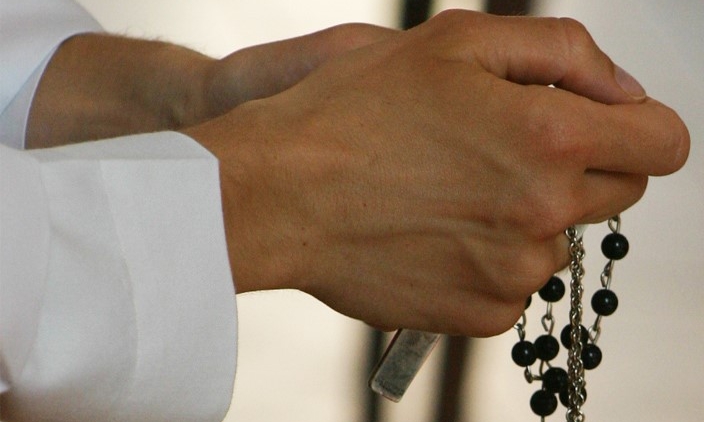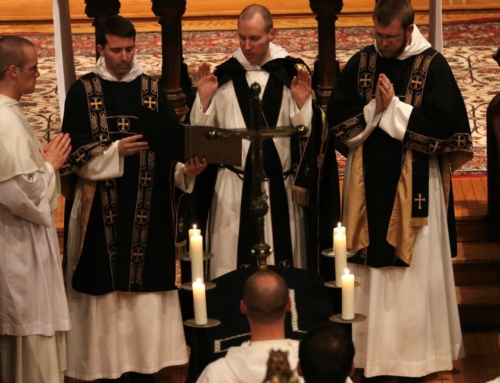A little over a year ago, some Dominican brothers and I participated in a procession with the World Youth Day Jubilee Cross and Marian icon when it was making the rounds through the US before heading for Panama this past January. As the procession strung out from the local Saint John Paul II National Shrine to the Basilica of the Immaculate Conception, some quiet chatter emerged among the participants, and a Dominican sister walking right ahead of me was speaking with a woman in her 20s.
After some light conversation, the sister casually asked the young woman if she wanted to pray the Rosary together as they walked toward the Basilica. “I’d love to,” the woman replied, “but I don’t have one on me.” At which point the sister promptly reached into her habit, whipped out a rosary, and shared it with the woman, who was astonished.
“You carry an extra rosary on you, even though you have that big one on your habit?!”
“Of course,” the sister said. “It’s like a rifle and a revolver! I’m from Texas.”
When one thinks of “packing heat” and “concealed carry,” rosary beads aren’t typically the first thing that comes to mind. But if we’re following St. Paul’s instruction to “set [our] minds on the things that are above” (Col 3:2), then it probably should, for in the realm of spiritual weaponry, the Rosary most definitely qualifies as artillery.
It may seem paradoxical, perhaps, to describe as a weapon an instrument like the Rosary, which facilitates such profound interior peace through decade after decade of recalling the angelic greeting to the Queen of Peace. But a fundamental reality of the Christian life, often far overlooked, is that we are all actually, right now, embattled in spiritual warfare, day in and day out. Saint Peter himself counsels as much: “Stay sober and alert. Your opponent the devil is prowling around like a roaring lion looking for someone to devour. Resist him, solid in your faith” (1 Pt 5:8–9a). Evil angels (demons) are real and active, and they do not desire our salvation (cf. Rev 12:7–9, 17).
The vigilance that St. Peter counsels finds realization in the regular recitation of the Rosary. Since its inception in the devotional life of the earliest Dominican friars—having been received by St. Dominic, as tradition holds, in a vision of Our Lady—the Rosary has been preeminent among devotional practices in the Church, and primarily because of its nobility and efficacy. (And which we celebrate throughout October, the Month of the Rosary, and especially today, the Feast of Our Lady of the Rosary, by recalling her role in the great victory at Lepanto.)
To meditate on the mysteries of the Rosary is to gaze upon Christ through the noble eyes of the one who loved him most. It is also to invoke the efficacious aid of the one about whom it was promised that enmity would be placed between her and Satan (cf. Gen 3:15) and between her seed—who would redeem reality—and the serpent’s sordid spawn, whose head her Son would crush.
It is in both of these senses that the Rosary is properly called a spiritual weapon. Combat weapons, rightly understood and deployed, have peace as their ultimate end; they are to be used in self-defense so as to neutralize an enemy and effect peace. Supernatural weapons—eminently, the Rosary—accomplish the same goal in the order of grace. Like a compendium of the Gospels (Rosarium Virginis Mariae 1), the Rosary always turns our eyes to Christ, the Prince of Peace, who is our ultimate end. Moreover, the very praying of the Rosary effects the destruction of the Lord’s enemies, who, yes—as the Book of Revelation attests—must be vanquished for peace to reign. Evil has no place in the Kingdom of God, to which Mary’s immaculate life bears vivid witness.
Every time, then, that we repeat the words of St. Gabriel and St. Elizabeth to Mary, we become purveyors of peace in imitation of the New Eve, that we might obtain the fruits won by the New Adam. And in doing so, we, like that Dominican sister, bear potent arms, “girding [our] swords upon [our] thighs / in splendor and state, rid[ing] on in triumph / for the cause of truth and goodness and right” (cf. Ps. 45:3–4).
✠
Photo used with the permission of the Dominican Sisters of St. Cecilia







